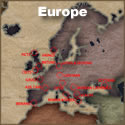Tattoos in Early England
During the 19th century, tattooing flourished in England like nowhere else in
Europe. This was due to the tradition of tattooing in the British Navy, which
began with the first voyage of Captain Cook in 1769. During the decades that
followed, many British seamen returned home bearing souvenirs of their travels
in the form of exotic tattoos. Sailors learned the art, and by the middle of the
18th century most British ports had at least one tattoo artist in residence.
Royal Tattoos
Tattooing gained royal sanction in 1862 when the Prince of Wales visited the
Holy Land and had a Jerusalem Cross tattooed on his arm. In later life, as King
Edward VII, he acquired a number of traditional tattoos. When his sons, the Duke
of Clarence and the Duke of York (later King George V), visited Japan in 1882,
Edward VII instructed their tutor to take them to the tattoo master Hori Chiyo,
who tattooed designs on their arms. On their way home, the two Dukes visited
Jerusalem and were tattooed by the same artist who had tattooed their father 20
years before.
Following the example of the Dukes, many wealthy Britons and naval officers
acquired tattoos from Japanese masters. Read this article that appeared in the 1898 Harmsworth Monthly Pictorial Magazine entitled
Tattooed Royalty. Queer Stories of a Queer Craze by R. J. Stephen,
for more about this "fad".
By 1890 the fad had spread to the US,
and tattoos were seen on members of the highest social circles.
The first British professional was D.W. Purdy who established a shop in North
London around 1870. In a booklet dated 1896, Purdy wrote:
"Before you commence to tattoo any individual you must be able to sketch
well, as it is very difficult matter to sketch on a person's arm or on any other
part of the body; you will have a good deal of rubbing out to do before you get
the figure drawn correctly. Whatever part of the body you have to tattoo you
must see that there are no large veins in the way, as they must be
avoided… Before you commence drawing out your figure you must see that hairs are
shaved off or you will have some difficulty in trying to sketch…"
The 1897 article by Gambier Bolton that appeared in The Strand magazine
entitled Pictures in the Human Skin
gives an overview of the tattoo scene of the late 1800's.
During the 19th century, tattooing was approved of and even encouraged in the
British army. Field Marshall Earl Roberts, who himself was tattooed, directed
that "every officer in the British Army should be tattooed with his regimental
crest. Not only does this encourage esprit de corps but also assists in the
identification of casualties.
One of the most prominent British tattoo artists of the late 19th century was
Tom Riley. Riley had a natural talent for drawing that he developed into
tattooing thousands of regimental crests and other military designs during the
South African War and the Sudan Campaign. After leaving the army, Riley
established himself as a tattoo artist in London.
His cousin, Samuel O'Reilly was a successful New York tattooist who invented
and patented the first electric tattooing machine in 1890.
Riley's success was not only due to his sill but also his salesmanship. One
of his original publicity stunts was the over-all tattooing of an Indian water
buffalo at the Paris Hippodrome in 1904.
Riley's greatest rival was Sutherland Macdonald. Like Reilly, Macdonald
learned tattooing while serving in the British army and later enjoyed the
benefit of formal art school training. In 1890 he opened a London studio. He
dressed formally and called himself a "tattooist" rather than a "tattooer".
Macdonald enjoyed a privileged status with the Royal Navy and he advanced his
career by courting journalists so that he became the subject of flattering
magazines and newspaper articles. In 1897, Le Temps reported that he had
elevated tattooing to an art form and in 1900 he was referred to in
L'Illustration as "the Michelangelo of tattooing." MacDonald continued to tattoo
until his death in 1937.
George Burchett, is considered one of the greatest of the early British
tattoo artists. He began his professional career in 1900, when Riley and
Macdonald were at the height of their fame. As a child he was fascinated by
tattoos and at age 13, he enlisted in the navy and learned the rudiments of
tattoo art. After roaming the world for twelve years, he returned to England and
at 28, he opened his first studio and began a career that earned him fame, a
small fortune and the title, "King of Tattooists".
Burchett is the only early British tattoo artist who left a written record of his
life and his work. After his death, his friend helped compile and edit his
memoirs, diaries and other materials and in 1958 a book, Memoirs of a Tattooist
was published.
Tattoo Museum Bibliography, Resources and Links
 See all European Tattoo Culture Articles here
See all European Tattoo Culture Articles here
NEXT >>
France & Italy
